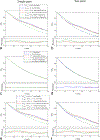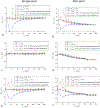Correction of errors in estimates of T1ρ at low spin-lock amplitudes in the presence of B0 and B1 inhomogeneities
- PMID: 37070215
- PMCID: PMC10619883
- DOI: 10.1002/nbm.4951
Correction of errors in estimates of T1ρ at low spin-lock amplitudes in the presence of B0 and B1 inhomogeneities
Abstract
Relaxation rates R1ρ in the rotating frame measured by spin-lock methods at very low locking amplitudes (≤ 100 Hz) are sensitive to the effects of water diffusion in intrinsic gradients and may provide information on tissue microvasculature, but accurate estimates are challenging in the presence of B0 and B1 inhomogeneities. Although composite pulse preparations have been developed to compensate for nonuniform fields, the transverse magnetization comprises different components and the spin-lock signals measured do not decay exponentially as a function of locking interval at low locking amplitudes. For example, during a typical preparation sequence, some of the magnetization in the transverse plane is nutated to the Z-axis and later tipped back, and so does not experience R1ρ relaxation. As a result, if the spin-lock signals are fit to a monoexponential decay with locking interval, there are residual errors in quantitative estimates of relaxation rates R1ρ and their dispersion with weak locking fields. We developed an approximate theoretical analysis to model the behaviors of the different components of the magnetization, which provides a means to correct these errors. The performance of this correction approach was evaluated both through numerical simulations and on human brain images at 3 T, and compared with a previous correction method using matrix multiplication. Our correction approach has better performance than the previous method at low locking amplitudes. Through careful shimming, the correction approach can be applied in studies using low spin-lock amplitudes to assess the contribution of diffusion to R1ρ dispersion and to derive estimates of microvascular sizes and spacings. The results of imaging eight healthy subjects suggest that R1ρ dispersion in human brain at low locking fields arises from diffusion among inhomogeneities that generate intrinsic gradients on a scale of capillaries (~7.4 ± 0.5 μm).
Keywords: R1ρ fitting error; diffusion; low power; microvasculature; spin-lock; susceptibility gradients; vessel size.
© 2023 John Wiley & Sons Ltd.
Figures









Similar articles
-
Tissue characterization using R1rho dispersion imaging at low locking fields.Magn Reson Imaging. 2021 Dec;84:1-11. doi: 10.1016/j.mri.2021.05.006. Epub 2021 May 28. Magn Reson Imaging. 2021. PMID: 34052306 Review.
-
Dispersion of relaxation rates in the rotating frame under the action of spin-locking pulses and diffusion in inhomogeneous magnetic fields.Magn Reson Med. 2014 May;71(5):1906-11. doi: 10.1002/mrm.24837. Epub 2013 Jun 26. Magn Reson Med. 2014. PMID: 23804212 Free PMC article.
-
Functional MRI using spin lock editing preparation pulses.Magn Reson Imaging. 2014 Sep;32(7):813-8. doi: 10.1016/j.mri.2014.04.001. Epub 2014 Apr 13. Magn Reson Imaging. 2014. PMID: 24848291 Free PMC article.
-
New insights into rotating frame relaxation at high field.NMR Biomed. 2016 Sep;29(9):1258-73. doi: 10.1002/nbm.3490. Epub 2016 Feb 11. NMR Biomed. 2016. PMID: 26866422 Free PMC article. Review.
-
Balanced spin-lock preparation for B1 -insensitive and B0 -insensitive quantification of the rotating frame relaxation time T1ρ.Magn Reson Med. 2021 May;85(5):2771-2780. doi: 10.1002/mrm.28585. Epub 2020 Nov 9. Magn Reson Med. 2021. PMID: 33166009
References
-
- Redfield AG. Nuclear Magnetic Resonance Saturation And Rotary Saturation In Solids. Phys Rev 1955;98(6):1787–1809.
Grants and funding
LinkOut - more resources
Full Text Sources
Research Materials

